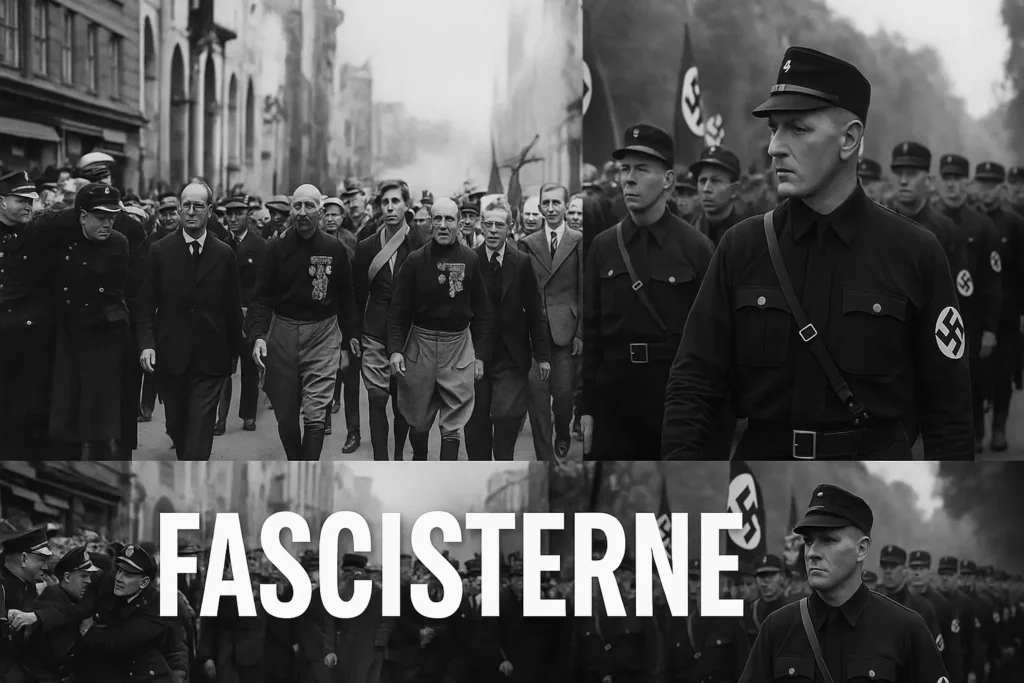The term fascisterne is far more than a simple label in political language; it carries a complex legacy that reaches from the battlefields of the Second World War to the pages of today’s newspapers. In Danish, the word means “the fascists,” but its weight lies in the history and ideology it represents. Whether used in historical accounts, political analysis, or modern social commentary, fascisterne embodies ideas and movements that have shaped—and in some cases scarred—societies.
This article will explore the origins of fascisterne, the ideology that defines them, their historical role in Europe and Denmark, their portrayal in modern discourse, and the lessons they offer for the future. By looking deeper, we aim to understand why this term remains relevant and why its meaning must be preserved.
What Fascisterne Means in Language and Politics
In linguistic terms, fascisterne is the plural form of “fascist” in Danish. While it may seem like a straightforward translation, it functions in multiple ways:
- Descriptive Term – Used in academic, historical, or journalistic writing to identify individuals or groups who adhere to fascist ideology.
- Political Weapon – Deployed in debates as a charged accusation against political opponents, often to criticize authoritarian tendencies or extremist policies.
Because of this dual function, the interpretation of fascisterne depends heavily on context. A historian using it to describe Italy under Mussolini operates differently from a protester using it in a political rally.
The Ideology Behind Fascisterne
To understand the power of the term, one must understand the ideology that binds fascisterne together. Fascism is not a vague insult but a defined political system with key characteristics:
- Authoritarianism – Centralized power in the hands of a leader or ruling elite, often without democratic checks.
- Extreme Nationalism – A belief in the supremacy of a single national or ethnic identity, often at the expense of minorities.
- Militarism – The glorification of military power and the normalization of violence as a political tool.
- Suppression of Opposition – Silencing dissent through censorship, intimidation, or imprisonment.
- Cult of Personality – Elevating a leader as the embodiment of the nation’s will.
These elements combined make fascisterne more than just political opponents—they become agents of a system that seeks to dominate every aspect of public and private life.
Historical Emergence in Europe
The first movements labeled as fascisterne arose in post–World War I Italy. Benito Mussolini’s Fascist Party capitalized on economic instability, social unrest, and fear of communism. By promising national revival, strict order, and unity, the fascists gained mass appeal. Their success inspired similar movements across Europe, most notably Adolf Hitler’s Nazi regime in Germany, Francisco Franco’s rule in Spain, and others in Hungary, Romania, and beyond.
These regimes shared key traits: they dismantled democratic systems, controlled the media, and used propaganda to shape public opinion. In practice, the ideology of fascisterne led to war, oppression, and genocide. The devastation of World War II, in which millions perished, cemented fascism’s place in history as a destructive and dangerous force.
Fascisterne in Danish History
Denmark’s experience with fascisterne is tied closely to the German occupation during World War II. While the country initially attempted to maintain neutrality, the Nazi invasion in 1940 brought political and social upheaval.
- Collaboration and Resistance – A small segment of Danish society aligned with the occupying forces, joining pro-German parties or paramilitary groups. These individuals are often remembered as fascisterne in the historical narrative.
- DNSB and Other Movements – The National Socialist Movement of Denmark (DNSB) and similar groups carried fascist and neo-Nazi ideologies into the postwar period. Although never a dominant force, they have maintained a presence in Denmark’s political fringe.
Today, fascisterne in the Danish context may refer to historical collaborators or to contemporary extremist organizations that share similar beliefs.
Modern-Day Usage of Fascisterne
In contemporary politics, the term is frequently used in public protests, media commentary, and online discussions. It may appear in debates about immigration, freedom of speech, or national identity. Sometimes, the term is applied broadly to describe any authoritarian or far-right movement, which raises questions about accuracy.
The challenge for modern commentators is ensuring that when they refer to fascisterne, they do so based on clear evidence of ideology and behavior, rather than as a blanket insult. Precision preserves the seriousness of the term and ensures it retains its historical and political weight.
Media Representation and Public Perception
Media coverage plays a crucial role in shaping how people understand fascisterne. Responsible reporting involves:
- Providing historical context alongside current events.
- Differentiating between far-right populism and explicit fascist ideology.
- Avoiding sensationalism that can distort public understanding.
When the media handles the term carefully, it helps citizens recognize genuine threats without fueling unnecessary fear or division.
Signs of Fascist Tendencies
Recognizing movements or individuals who may be part of fascisterne involves looking for consistent patterns:
- Centralization of power with minimal accountability.
- Demonization of minority groups or political opponents.
- Suppression of the press and control over public messaging.
- Use of violence or intimidation to influence political outcomes.
- Manipulation of democratic systems to maintain permanent control.
These patterns have appeared in multiple historical and modern contexts, making vigilance important for maintaining democratic integrity.
Legal and Civic Responses
Governments and civil society can address the threat of fascisterne in several ways:
- Legislation – Enforcing laws against hate crimes, political violence, and incitement.
- Education – Teaching historical awareness and critical thinking to recognize extremist propaganda.
- Community Engagement – Supporting inclusive policies that reduce the appeal of extremist ideologies.
By combining these strategies, societies can weaken the influence of fascisterne without undermining freedoms.
Lessons from History for Today
History offers clear warnings: ignoring extremist rhetoric and organization can lead to political collapse and widespread violence. The rise of fascisterne in the twentieth century often went unchecked until it was too late. Today, early recognition and democratic resilience are key to preventing a repeat of the past.
Conclusion
Fascisterne are not just historical figures locked in dusty archives; they represent a living political danger when their ideas resurface in modern times. By understanding their ideology, history, and tactics, we can better defend democratic values and ensure that the mistakes of the past are not repeated. Precision in language, awareness of history, and active civic engagement remain our strongest tools in countering authoritarian movements.
FAQs
What does fascisterne mean?
It means “the fascists” in Danish, referring to groups or individuals who follow fascist ideology.
When did fascisterne first appear in Europe?
They emerged in Italy after World War I under Benito Mussolini and spread to other countries like Germany and Spain.
How are fascisterne identified today?
Through patterns of authoritarianism, suppression of opposition, extreme nationalism, and intolerance of diversity.
Are fascisterne still a threat in modern society?
Yes; while often on the political fringe, extremist movements can grow if left unchallenged.
How can societies counter fascisterne?
By combining education, community engagement, and legal measures to prevent extremist violence and protect democratic freedoms.

